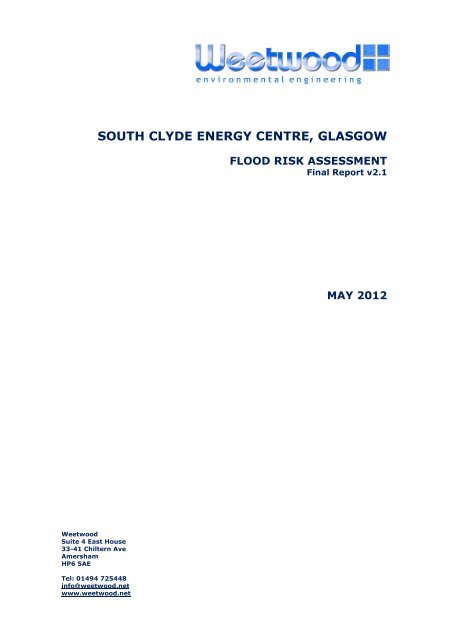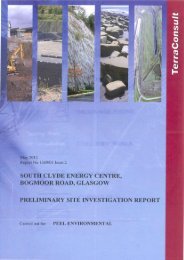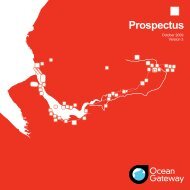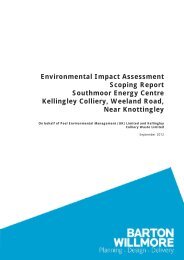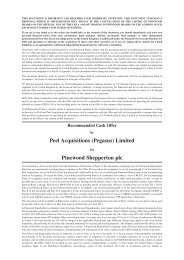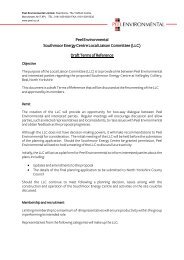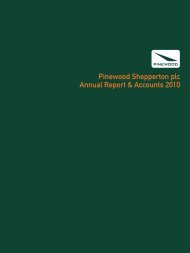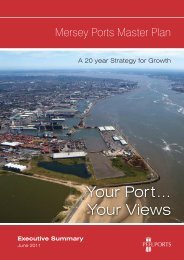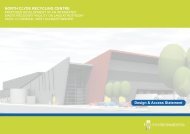Appendix 8.1 Flood Risk Assessment - Peel
Appendix 8.1 Flood Risk Assessment - Peel
Appendix 8.1 Flood Risk Assessment - Peel
You also want an ePaper? Increase the reach of your titles
YUMPU automatically turns print PDFs into web optimized ePapers that Google loves.
SOUTH CLYDE ENERGY CENTRE, GLASGOW<br />
FLOOD RISK ASSESSMENT<br />
Final Report v2.1<br />
MAY 2012<br />
Weetwood<br />
Suite 4 East House<br />
33-41 Chiltern Ave<br />
Amersham<br />
HP6 5AE<br />
Tel: 01494 725448<br />
info@weetwood.net<br />
www.weetwood.net
<strong>Peel</strong> Environmental Ltd<br />
<strong>Flood</strong> <strong>Risk</strong> <strong>Assessment</strong> – South Clyde Energy Centre, Glasgow<br />
Report Title:<br />
Client:<br />
South Clyde Energy Centre, Glasgow<br />
<strong>Flood</strong> <strong>Risk</strong> <strong>Assessment</strong><br />
Final Report v2.1<br />
<strong>Peel</strong> Environmental Ltd<br />
Date of Issue: 14 May 2012<br />
Prepared by:<br />
Checked by:<br />
Approved by:<br />
Sarah Cowie BSc<br />
Project Manager<br />
Geoff Waite BSc CEng C.WEM MICE MCIWEM<br />
Director<br />
Andrew Grime BEng MBA CEng C.WEM MICE FCIWEM<br />
Managing Director<br />
This document has been prepared solely as a <strong>Flood</strong> <strong>Risk</strong> for <strong>Peel</strong> Environmental Ltd. Weetwood<br />
Services Ltd accepts no responsibility or liability for any use that is made of this document<br />
other than by the Client for the purposes for which it was originally commissioned and<br />
prepared.<br />
©Weetwood<br />
www.weetwood.net<br />
i 1727 SCEC/FRA_Final v2.1<br />
14 May 2012
<strong>Peel</strong> Environmental Ltd<br />
<strong>Flood</strong> <strong>Risk</strong> <strong>Assessment</strong> – South Clyde Energy Centre, Glasgow<br />
CONTENTS<br />
Signature Sheet<br />
Contents<br />
List of Figures & Appendices<br />
Page<br />
i<br />
ii<br />
iii<br />
1 INTRODUCTION ............................................................... 1<br />
1.1 SITE LOCATION .........................................................................................1<br />
1.2 EXISTING AND PROPOSED DEVELOPMENT ....................................................2<br />
1.3 SITE LEVELS .............................................................................................2<br />
1.4 ACCESS AND EGRESS.................................................................................2<br />
2 SCOTTISH PLANNING POLICY............................................. 3<br />
2.1 SCOTTISH ENVIRONMENT PROTECTION AGENCY FLOOD MAP .........................3<br />
2.2 DEVELOPMENT AND FLOOD RISK.................................................................3<br />
2.3 STRATEGIC FLOOD RISK ASSESSMENT.........................................................4<br />
3 FLOOD RISK .................................................................... 5<br />
3.1 RIVER CLYDE.............................................................................................5<br />
3.2 UNNAMED WATERCOURSE ..........................................................................6<br />
3.3 GROUNDWATER FLOODING.........................................................................9<br />
3.4 SURFACE WATER FLOODING ..................................................................... 10<br />
3.5 ACCESS AND EGRESS............................................................................... 11<br />
4 CONCLUSIONS............................................................... 12<br />
©Weetwood<br />
www.weetwood.net<br />
ii 1727 SCEC/FRA_Final v2.1<br />
14 May 2012
<strong>Peel</strong> Environmental Ltd<br />
<strong>Flood</strong> <strong>Risk</strong> <strong>Assessment</strong> – South Clyde Energy Centre, Glasgow<br />
LIST OF FIGURES<br />
Figure 1: Site Location.......................................................................................1<br />
Figure 2: SEPA <strong>Flood</strong> Map ..................................................................................3<br />
Figure 3: River Clyde.........................................................................................5<br />
Figure 4: Extract from Sewer Records .................................................................6<br />
Figure 5: Unnamed Watercourse.........................................................................7<br />
Figure 6: Inlet to 450mm Culvert Under Site ........................................................7<br />
Figure 7: LiDAR Data.........................................................................................9<br />
LIST OF APPENDICES<br />
<strong>Appendix</strong> A:<br />
<strong>Appendix</strong> B:<br />
<strong>Appendix</strong> C:<br />
<strong>Appendix</strong> D:<br />
<strong>Appendix</strong> E:<br />
Site Location Plan<br />
Site Photos<br />
Development Proposals<br />
Topographic Survey<br />
Public Sewer Records<br />
©Weetwood<br />
www.weetwood.net<br />
iii 1727 SCEC/FRA_Final v2.1<br />
14 May 2012
<strong>Peel</strong> Environmental Ltd<br />
<strong>Flood</strong> <strong>Risk</strong> <strong>Assessment</strong> – South Clyde Energy Centre, Glasgow<br />
1 INTRODUCTION<br />
Weetwood were instructed to undertake a <strong>Flood</strong> <strong>Risk</strong> <strong>Assessment</strong> by <strong>Peel</strong><br />
Environmental Ltd in connection with the proposed development of an energy<br />
from waste plant (South Clyde Energy Centre) on a site situated off Bogmoor<br />
Road, Glasgow. The assessment has been prepared in accordance with the<br />
requirements of Scottish Planning Policy (2010) and its supporting guidance<br />
documents including Planning Advice Note 69 (PAN69): Planning and Building<br />
Standards Advice on <strong>Flood</strong>ing. The report has also been prepared with<br />
reference to the <strong>Flood</strong> <strong>Risk</strong> Management (Scotland) Act (2009).<br />
This report is based on studies of relevant detail and consultation with<br />
Glasgow City Council (CC) and the Scottish Environmental Protection Agency<br />
(SEPA). Weetwood has also produced a separate Drainage Impact <strong>Assessment</strong><br />
(DIA) 1 for this site in order to assess any likely impact of the proposals on<br />
surface water runoff.<br />
1.1 SITE LOCATION<br />
The site is located off Bogmoor Road, at Ordnance Survey National Grid<br />
Reference NS 529 654 (see Figure 1.)<br />
King George V Dock<br />
River Clyde<br />
Hillington Road<br />
Bogmoor Road Site<br />
Bogmoor Road<br />
Johnstone Avenue<br />
Sheildhall Road (A8)<br />
Railway Line<br />
M8<br />
Image reproduced with permission of Ordnance Survey and Ordnance Survey of Northern Ireland<br />
Figure 1: Site Location<br />
A more detailed site location plan is provided in <strong>Appendix</strong> A, which shows the<br />
existing site layout and location of relevant features in the vicinity of the site.<br />
Photos of the site and relevant features are provided in <strong>Appendix</strong> B.<br />
1 “South Clyde Energy Centre, Glasgow: Drainage Impact <strong>Assessment</strong>”, Report. Ref: 1727 SCEC/DIAv2.1, 14 May<br />
2012<br />
©Weetwood<br />
www.weetwood.net<br />
1 1727 SCEC/FRA_Final v2.1<br />
14 May 2012
<strong>Peel</strong> Environmental Ltd<br />
<strong>Flood</strong> <strong>Risk</strong> <strong>Assessment</strong> – South Clyde Energy Centre, Glasgow<br />
1.2 EXISTING AND PROPOSED DEVELOPMENT<br />
The site has been previously developed, but is now vacant. The site consists of<br />
areas of hardstanding with some overgrown, permeable land. The current<br />
masterplan showing the development proposals is included in <strong>Appendix</strong> C.<br />
The proposals are for construction of a waste management facility – an Energy<br />
from Waste (EfW) plant.<br />
1.3 SITE LEVELS<br />
A topographic survey of the site has been undertaken and is included as<br />
<strong>Appendix</strong> D of this report. The survey indicates that site levels increase from<br />
7.50m Above Ordnance Datum (mAOD) in the north of the site to 10.00mAOD<br />
in the south.<br />
1.4 ACCESS AND EGRESS<br />
Access and egress to the site is provided directly off Bogmoor Road to the<br />
southeast of the site (Figure 1). Levels along this route are shown to fall from<br />
8.54mAOD near the site to 8.02mAOD to the northeast.<br />
©Weetwood<br />
www.weetwood.net<br />
2 1727 SCEC/FRA_Final v2.1<br />
14 May 2012
<strong>Peel</strong> Environmental Ltd<br />
<strong>Flood</strong> <strong>Risk</strong> <strong>Assessment</strong> – South Clyde Energy Centre, Glasgow<br />
2 SCOTTISH PLANNING POLICY<br />
2.1 SCOTTISH ENVIRONMENT PROTECTION AGENCY FLOOD MAP<br />
According to the latest SEPA flood map for this area (Figure 2), the site is<br />
located outside those areas defined as being at risk of flooding from rivers<br />
and/or the sea.<br />
Figure 2: SEPA <strong>Flood</strong> Map<br />
2.2 DEVELOPMENT AND FLOOD RISK<br />
The <strong>Risk</strong> Framework outlined in Scottish Planning Policy defines flood risk<br />
using the following three categories:<br />
1. Little or no risk – Annual probability of watercourse, tidal or coastal<br />
flooding is less than 0.1% (1:1000)<br />
2. Low to medium risk – Annual probability of watercourse, tidal or coastal<br />
flooding is in the range 0.1% - 0.5% (1:1000 – 1:200)<br />
3. Medium to high risk – Annual probability of watercourse, tidal or coastal<br />
flooding is greater than 0.5% (1:200)<br />
According to the SEPA flood map the site is considered to be at little or no risk<br />
of flooding from rivers and/or sea. This is discussed in more detail in Section<br />
3.<br />
©Weetwood<br />
www.weetwood.net<br />
3 1727 SCEC/FRA_Final v2.1<br />
14 May 2012
<strong>Peel</strong> Environmental Ltd<br />
<strong>Flood</strong> <strong>Risk</strong> <strong>Assessment</strong> – South Clyde Energy Centre, Glasgow<br />
2.3 STRATEGIC FLOOD RISK ASSESSMENT<br />
Glasgow CC have not yet published their Strategic <strong>Flood</strong> <strong>Risk</strong> <strong>Assessment</strong> 2 .<br />
SEPA have produced a “Local Plan Districts and Potentially Vulnerable Areas”<br />
report in line with the requirements of the <strong>Flood</strong> <strong>Risk</strong> Management (Scotland)<br />
Act (2009). The information contained has been used to inform this report.<br />
Glasgow CC guidance 3 states that a <strong>Flood</strong> <strong>Risk</strong> and Drainage Impact<br />
<strong>Assessment</strong> (FRA) “is now required for any residential development comprising<br />
more than 5 dwellings and for industrial or commercial developments of more<br />
than 250m 2 …The FRA will be required to certify that any flood risk associated<br />
with the development can be managed now and in the future, taking into<br />
account climate change and illustrate how the development will not increase<br />
the risk of flooding elsewhere.”<br />
2 Confirmed in email from David Russell (Gralsgow CC) to Sarah Cowie (Weetwood) dated 14 February 2011<br />
3 <strong>Flood</strong> <strong>Risk</strong> <strong>Assessment</strong> and Drainage Impact <strong>Assessment</strong>: Planning Guidance for Developers, Glasgow City Council,<br />
October 2009<br />
©Weetwood<br />
www.weetwood.net<br />
4 1727 SCEC/FRA_Final v2.1<br />
14 May 2012
<strong>Peel</strong> Environmental Ltd<br />
<strong>Flood</strong> <strong>Risk</strong> <strong>Assessment</strong> – South Clyde Energy Centre, Glasgow<br />
3 FLOOD RISK<br />
3.1 RIVER CLYDE<br />
The River Clyde (see Figure 3) flows in a westerly direction to the north of the<br />
site. The site does not benefit from flood defences for the River Clyde.<br />
Figure 3: River Clyde<br />
This section of the River Clyde is tidally dominated. The site is shown to lie<br />
outside the area at risk of flooding (see Figure 2). SEPA were contacted for<br />
information concerning the level of risk to the site. Their response 4 stated<br />
that, “Review of the Indicative River & Coastal <strong>Flood</strong> Map (Scotland) 200-year<br />
flood outline (i.e. the flood with a 0.5% chance of occurring in any single year)<br />
indicates that this area lies out-with this envelope.”<br />
Glasgow CC were also consulted regarding the level of flood risk to the site.<br />
Their response 5 stated that, “The Bogmoor Road site referred to is located<br />
within the (general) vicinity of the River Clyde and is out-with an area<br />
currently identified as likely to flood during a design flood event. Development<br />
of the Bogmoor Road site does not represent an increased flood risk to the<br />
River Clyde catchment and…a <strong>Flood</strong> <strong>Risk</strong> <strong>Assessment</strong> is not required in this<br />
instance with regard to the River Clyde.”<br />
Glasgow CC have not identified any records of flooding at the site.<br />
The site is therefore not considered to be at risk of flooding from the River<br />
Clyde.<br />
4 Email from Nicola Rae (SEPA) to Sarah Cowie (Weetwood) dated 15 December 2010<br />
5 Email from John Lowe (Glasgow CC) to Sarah Cowie (Weetwood) dated 15 December 2010<br />
©Weetwood<br />
www.weetwood.net<br />
5 1727 SCEC/FRA_Final v2.1<br />
14 May 2012
<strong>Peel</strong> Environmental Ltd<br />
<strong>Flood</strong> <strong>Risk</strong> <strong>Assessment</strong> – South Clyde Energy Centre, Glasgow<br />
3.2 UNNAMED WATERCOURSE<br />
A railway line runs along the western boundary of the site. A small unnamed<br />
watercourse is located to the west of the railway. The sewer records in<br />
<strong>Appendix</strong> E show that this watercourse approaches the site from the south<br />
via a 675mm culvert. The culvert outfalls into a section of open channel which<br />
flows alongside the railway line. Figure 4 is an extract from the sewer records<br />
and shows the location of relevant features discussed in the following sections.<br />
1200mm surface<br />
water sewer<br />
450mm culvert<br />
Site<br />
Railway Line<br />
900x1,350mm<br />
combined sewer<br />
450mm culvert inlet<br />
375mm surface<br />
water sewer<br />
Open Channel<br />
675mm culvert outlet<br />
Figure 4: Extract from Sewer Records<br />
©Weetwood<br />
www.weetwood.net<br />
6 1727 SCEC/FRA_Final v2.1<br />
14 May 2012
<strong>Peel</strong> Environmental Ltd<br />
<strong>Flood</strong> <strong>Risk</strong> <strong>Assessment</strong> – South Clyde Energy Centre, Glasgow<br />
During the site visit 6 , it was seen that water within the channel was generally<br />
stagnant with little obvious flow. The only outlet from this section of open<br />
channel appeared to be via a 450mm culvert located approximately half way<br />
along the channel length (see Figure 4 and Figure 6). The 450mm culvert<br />
conveys flows north across the site and connects into a 1,200mm public<br />
surface water sewer (manhole number 7701). The 1,200mm sewer then runs<br />
northeast under the site towards the River Clyde.<br />
A 375mm public surface water sewer is shown in <strong>Appendix</strong> E and Figure 4 to<br />
connect with the 450mm culvert near the offtake from the open channel. This<br />
pipe was not seen during the site visit, so it is believed to run under the open<br />
channel into the 450mm culvert, rather than outfalling into the channel itself.<br />
Figure 5: Unnamed Watercourse<br />
Figure 6: Inlet to 450mm Culvert Under Site<br />
6 Undertaken on 14 January 2011<br />
©Weetwood<br />
www.weetwood.net<br />
7 1727 SCEC/FRA_Final v2.1<br />
14 May 2012
<strong>Peel</strong> Environmental Ltd<br />
<strong>Flood</strong> <strong>Risk</strong> <strong>Assessment</strong> – South Clyde Energy Centre, Glasgow<br />
SEPA have confirmed 7 that they hold no information regarding the risk of<br />
flooding from the unnamed watercourse. Glasgow CC have also not raised any<br />
concerns regarding flooding from this watercourse. The catchment area of the<br />
unnamed watercourse has been investigated on the FEH CD v3 produced by<br />
the Centre for Ecology and Hydrology. The minimum catchment size on the<br />
FEH CD is 0.5 km 2 . The catchment area for this watercourse is not shown,<br />
inferring that it is less than 0.5 km 2 .<br />
3.2.1 <strong>Risk</strong> of <strong>Flood</strong>ing from Unnamed Watercourse<br />
In order for the site to be at risk of flooding from the unnamed watercourse,<br />
floodwaters would need to overtop the channel and the railway line. The most<br />
likely location for overtopping would be upstream of the 450mm culvert under<br />
the railway line (see Figure 6). The 450mm culvert is smaller than the<br />
675mm culvert upstream of the open channel and may well restrict flows<br />
leaving the open channel. The culvert entrance may also be prone to blockage,<br />
especially given the amount of debris in the open channel upstream (see<br />
Figure 5). Should water from the open channel be unable to discharge<br />
through the culvert under to the site due to blockage, floodwaters would build<br />
up within the channel.<br />
The catchment of the unnamed watercourse is believed to be less than 0.5km 2<br />
in area and highly urbanised. The urbanisation means that the catchment is<br />
likely to have a rapid response time. However, it also means that the<br />
catchment will probably drain mainly via the public sewer system. In the<br />
vicinity of the site, the public surface water sewer system includes a 1,200mm<br />
public surface water sewer running through the site, and the combined sewers<br />
under Bogmoor Road (<strong>Appendix</strong> E). One of these combined sewers measures<br />
900mm x 1,350mm in size. The capacity of the surface water drainage system<br />
in the vicinity of the site is therefore much larger than the capacity of the<br />
culverts associated with the unnamed watercourse. Given this, the<br />
watercourse catchment is believed to drain primarily via the public sewer<br />
system, with only minor flows reaching the open channel near the site.<br />
Observations during the site visit support this conclusion. Despite the fact that<br />
it was raining during the site visit, water within the open channel was<br />
generally stagnant with no significant rates of flow observed. In addition, the<br />
open channel has a relatively large capacity in relation to the observed flow. It<br />
is therefore not considered that the site is at risk of flooding from the<br />
unnamed watercourse.<br />
In the unlikely event that the open channel filled to capacity (e.g. if the<br />
450mm outflow culvert became completely blocked) water would need to<br />
overtop the railway line before reaching the site. LiDAR data has been<br />
obtained for the site and surrounding area. The cross sections in Figure 7<br />
overleaf show that the depth of water within the open channel would need to<br />
exceed 1.5m before overtopping the railway line. <strong>Flood</strong>waters would then<br />
spread out to cover the large area of low-lying land available in the vicinity of<br />
the site rather than building up to a depth sufficient to pose a risk to users of<br />
the site.<br />
7 See footnote 2<br />
©Weetwood<br />
www.weetwood.net<br />
8 1727 SCEC/FRA_Final v2.1<br />
14 May 2012
<strong>Peel</strong> Environmental Ltd<br />
<strong>Flood</strong> <strong>Risk</strong> <strong>Assessment</strong> – South Clyde Energy Centre, Glasgow<br />
Recognising the above, it is not considered that the site is at significant risk of<br />
flooding from the unnamed watercourse.<br />
Open Channel<br />
Railway Line<br />
Site<br />
Open Channel<br />
Railway Line<br />
Site<br />
Cross Section 1 Cross Section 2<br />
Open Channel<br />
Railway Line<br />
Site<br />
Cross Section 3<br />
Figure 7: LiDAR Data<br />
3.3 GROUNDWATER FLOODING<br />
Groundwater flooding generally occurs during intense, long-duration rainfall<br />
events, when infiltration of rainwater into the ground raises the level of the<br />
water table until it exceeds ground levels. It is most common in low-lying<br />
areas overlain by permeable soils and permeable geology, or in areas with a<br />
naturally high water table.<br />
Paragraph 21 of PAN69 states that ‘water tables are not rising generally in<br />
Scotland, but there can be localised problems in some areas’. SEPA’s “Local<br />
Plan Districts and Potentially Vulnerable Areas” report 8 states that there is<br />
potentially a “low to moderate” risk of groundwater flooding within part of the<br />
catchment area, but does not provide any details of potential problems in the<br />
vicinity of the site.<br />
8 “Local Plan Districts and Potentially Vulnerable Areas – <strong>Flood</strong> <strong>Risk</strong> Management (Scotland) Act 2009 – 11 Clyde and<br />
Loch Lomond” SEPA, 2011<br />
©Weetwood<br />
www.weetwood.net<br />
9 1727 SCEC/FRA_Final v2.1<br />
14 May 2012
<strong>Peel</strong> Environmental Ltd<br />
<strong>Flood</strong> <strong>Risk</strong> <strong>Assessment</strong> – South Clyde Energy Centre, Glasgow<br />
The British Geological Society Groundwater <strong>Flood</strong>ing Hazard Maps indicate that<br />
Glasgow is situated within an area with very low to low groundwater<br />
vulnerability. Glasgow CC have not provided 9 any information on groundwater<br />
flooding. Groundwater flooding is therefore not considered to be a significant<br />
source of flood risk to the site.<br />
3.4 SURFACE WATER FLOODING<br />
Surface water flooding comprises pluvial flooding, sewer flooding and<br />
flooding from highway drains and gullies.<br />
3.4.1 Pluvial <strong>Flood</strong>ing<br />
Pluvial flooding results from rainfall-generated overland flow, before the runoff<br />
enters any watercourse or sewer, or where the sewerage/drainage systems<br />
and watercourses are overwhelmed and therefore unable to accept surface<br />
water. Pluvial flooding is usually associated with high intensity rainfall events<br />
but may also occur with lower intensity rainfall where the ground is saturated,<br />
developed or otherwise has low permeability resulting in overland flow and<br />
ponding within depressions in the topography.<br />
Glasgow CC have not identified any problems with pluvial flooding at the site.<br />
Any issues with regard to surface water flooding will be addressed through the<br />
surface water drainage scheme as outlined in the Drainage Impact<br />
<strong>Assessment</strong>.<br />
3.4.2 Sewer <strong>Flood</strong>ing<br />
Sewer flooding occurs when the sewerage infrastructure has to deal with flow<br />
rates beyond its design capacity. This occurs most often as a result of high<br />
intensity rainfall events and, as detailed in paragraph 16 of PAN69, is<br />
exacerbated by the fact that the sewage infrastructure in many parts of<br />
Scotland constitutes an old combined system, taking both foul sewerage and<br />
surface water.<br />
Scottish Water have not indicated any records of historical sewer flooding<br />
within this area.<br />
Scottish Planning Policy and PAN69 encourage new developments to separate<br />
surface and foul water discharges to reduce the volume of water entering the<br />
public sewer system. Scottish Planning Policy promotes the use of Sustainable<br />
Drainage Systems (SUDS) to address surface water drainage. SUDS are<br />
designed to manage the flow of surface water which could otherwise find its<br />
way into the public sewer network or receiving watercourse. By reducing the<br />
volume of surface water in a sewer, SUDS will subsequently reduce the<br />
likelihood of sewer or watercourse flooding.<br />
This is considered in further detail in the Drainage Impact <strong>Assessment</strong> with<br />
respect to the proposed development site.<br />
9 Email from John Lowe (Glasgow City Council) to Sarah Cowie (Weetwood) dated 15 December 2010<br />
©Weetwood<br />
www.weetwood.net<br />
10 1727 SCEC/FRA_Final v2.1<br />
14 May 2012
<strong>Peel</strong> Environmental Ltd<br />
<strong>Flood</strong> <strong>Risk</strong> <strong>Assessment</strong> – South Clyde Energy Centre, Glasgow<br />
3.5 ACCESS AND EGRESS<br />
Access to the site will be provided via Bogmoor Road to the north. Bogmoor<br />
Road lies outside any areas at risk of flooding from the River Clyde. It is<br />
considered unlikely that the unnamed watercourse to the west of the site<br />
would flood the area of Bogmoor Road to the extent and depths required to<br />
preclude access of egress for the site.<br />
Safe access and egress from the site may therefore be provided via Bogmoor<br />
Road.<br />
©Weetwood<br />
www.weetwood.net<br />
11 1727 SCEC/FRA_Final v2.1<br />
14 May 2012
<strong>Peel</strong> Environmental Ltd<br />
<strong>Flood</strong> <strong>Risk</strong> <strong>Assessment</strong> – South Clyde Energy Centre, Glasgow<br />
4 CONCLUSIONS<br />
There are proposals for construction of an EfW plant on an area of land located<br />
off Bogmoor Road, Glasgow. According to SEPA’s flood map the proposed<br />
development site is located within an area at little or no risk of flooding.<br />
The site is not considered to be at risk of flooding from the River Clyde. <strong>Flood</strong><br />
risk from an unnamed watercourse to the west is considered to be low.<br />
The site is not considered to be at risk from groundwater flooding or surface<br />
water flooding.<br />
Access and egress will be provided via Bogmoor Road, which is expected to<br />
remain safe for use in the event of a flood.<br />
©Weetwood<br />
www.weetwood.net<br />
12 1727 SCEC/FRA_Final v2.1<br />
14 May 2012
<strong>Peel</strong> Environmental Ltd<br />
<strong>Flood</strong> <strong>Risk</strong> <strong>Assessment</strong> – South Clyde Energy Centre, Glasgow<br />
APPENDIX A:<br />
Site Location Plan<br />
©Weetwood<br />
www.weetwood.net<br />
1727 SCEC/FRA_Final v2.1<br />
14 May 2012
<strong>Peel</strong> Environmental Ltd<br />
<strong>Flood</strong> <strong>Risk</strong> <strong>Assessment</strong> – South Clyde Energy Centre, Glasgow<br />
APPENDIX B:<br />
Site Photographs<br />
©Weetwood<br />
www.weetwood.net<br />
1727 SCEC/FRA_Final v2.1<br />
14 May 2012
<strong>Peel</strong> Environmental Ltd<br />
<strong>Flood</strong> <strong>Risk</strong> <strong>Assessment</strong> – South Clyde Energy Centre, Glasgow<br />
APPENDIX C:<br />
Development Proposals<br />
©Weetwood<br />
www.weetwood.net<br />
1727 SCEC/FRA_Final v2.1<br />
14 May 2012
<strong>Peel</strong> Environmental Ltd<br />
<strong>Flood</strong> <strong>Risk</strong> <strong>Assessment</strong> – South Clyde Energy Centre, Glasgow<br />
APPENDIX D:<br />
Topographic Survey<br />
©Weetwood<br />
www.weetwood.net<br />
1727 SCEC/FRA_Final v2.1<br />
14 May 2012
<strong>Peel</strong> Environmental Ltd<br />
<strong>Flood</strong> <strong>Risk</strong> <strong>Assessment</strong> – South Clyde Energy Centre, Glasgow<br />
APPENDIX E:<br />
Public Sewer Records<br />
©Weetwood<br />
www.weetwood.net<br />
1727 SCEC/FRA_Final v2.1<br />
14 May 2012


